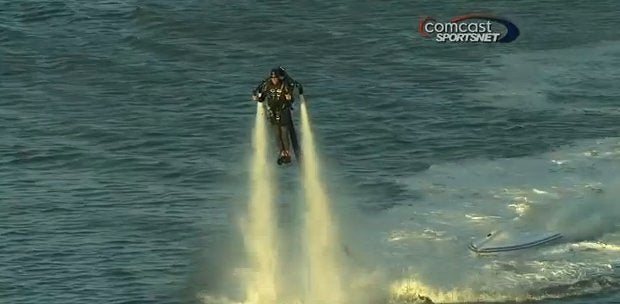
Ever since Sean Connery donned a Bell Rocket Belt in the 1965 movie, Thunderball, every guy who's reached the age of reason has wanted a jet pack of his own.
Unfortunately, the technology has suffered from some severe limitations. For example, Connery's jet pack only generated enough thrust to sustain 20 seconds of flight, not to mention a top altitude of 30 feet. That's not exactly what we had in mind when we think "jet pack."
Fortunately, Raymond Li, a Chinese-born Canadian, has solved many of these problems with the JETLEV R200. This nifty little device is a hydro-powered jet pack tethered to a 260 horsepower, four stroke, marine engine that promises the dream of personal flight. Though this is a bit of marketing hype given your altitude is still capped at 30 feet and you're tethered to a boat the size of a Jet Ski (not to mention a body of water), it's still a pretty cool implementation.

With a top speed of 30 mph and a "flight" duration of up to five hours, the JETLEV R200 surpasses Bonds' jet pack in some important ways. For example, its 80-mile operating range is far superior to what Bond had available, and the fact it runs on high-octane gasoline makes it a lot cheaper to operate than the nitrogen/hydrogen peroxide combo Bond required. Importantly, you only need a bathing suit to fly Li's jet pack. An asbestos flight suit was required for the Bell Rocket Belt, Bond's Savile Row threads notwithstanding.
According to the company's website, Li's aquatic jet pack generates 420 pounds of thrust by pumping 1,000 gallons of water per minute through its system. The water is directed out of two nozzles which extend below the jet pack and help control direction. A motorcycle-style throttle regulates thrust so an operator can climb, dive, or hover in place.
The JETLEV R200 costs $100,000, so it's not an every day purchase for most of us. The Florida-based company also seems to be casting a pretty wide net when it comes to customers. In addition to individual purchasers, they're targeting tour operators, advertisers, boating enthusiasts, and the military, scientific, and academic communities. That's another way of saying they haven't yet figured out who's going to buy this thing in any appreciable quantity. My guess is not many until the price point approaches the cost of a Jet Ski which varies from $10,000 to $15,000. But in the meantime, who cares? The damn thing flies!
According to the company's origination story, Mr. Li sketched out the JETLEV concept on a Post-It note back in 2000 but threw it away after deciding it was impossible to build. Three years later he was back at it and, with assistance from the National Research Council of Canada, tested a prototype. A production model was readied earlier this year.
JETLEV claims a propriety propulsion technology and has several patents pending. The aquatic invention even comes in a variety of colors so it won't clash with your yacht. Over 10 million YouTubers have viewed various JETLEV product demonstrations which the company says were accidentally "leaked" to the Internet (click here for one of them). To see a demo of a German competitor, the JETLEV-FLYER, with much better production values including a helicopter and cheesy music click here.
But, hey, all kidding aside, Mr. Li has nothing to be ashamed of whether or not he moves a lot of units at that outlandish price point. It's not everyday you can strap on a jet pack and feel like you're flying. Mr. Li is one of the few who's made it possible. The Institute thanks him.